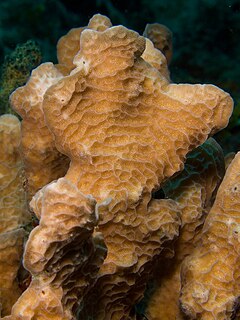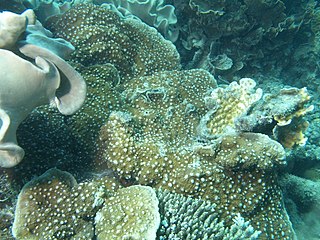
Acroporidae is a family of small polyped stony corals in the phylum Cnidaria. The name is derived from the Greek "akron" meaning "summit" and refers to the presence of a corallite at the tip of each branch of coral. They are commonly known as staghorn corals and are grown in aquaria by reef hobbyists.

Astreopora is a genus of stony corals in the Acroporidae family. Members of the genus are commonly known as star corals and there are seventeen species currently recognized.

The Pocilloporidae are a family of stony corals in the order Scleractinia occurring in the Pacific and Indian Oceans.

Favia is a genus of reef-building stony corals in the family Mussidae. Members of the genus are massive or thickly encrusting colonial corals, either dome-shaped or flat, and a few are foliaceous. There is a great diversity of form even among individuals of the same species. The corallites project slightly above the surface of the coral and each has its own wall. In most species, the corallites are plocoid and in some, monocentric. The septa and costae linked to the corallite wall are well developed and covered by fine teeth. The polyps only extend and feed during the night. Each one has a small number of tapering tentacles which often have a darker coloured tip; these are called stinger tentacles, or sweeper tentacles. They use these to sweep the water to see if any other coral is in its area; if so, then they begin to sting the other coral. This is commonly known as coral war. Each coral is trying to make sure it has enough room around it so it can continue to grow and have more surface area for its offspring. The columella is parietal and spongy, and there are vesicles on both the endotheca and exotheca. Members of this genus are widespread in both the Atlantic Ocean and the Indo-Pacific.

Fungia is a genus of corals in the family Fungiidae. It is monotypic with the single species Fungia fungites, which is found growing on reefs in the Indo-Pacific.

Cycloseris is a genus of solitary disc corals in the family Fungiidae. They are found in the Indo-Pacific. They inhabit the lower reef slopes, and the areas between reefs with soft sediments. They tolerate turbid waters.

Lobactis is a genus of plate or mushroom coral in the family Fungiidae. The genus is monotypic with a single species, Lobactis scutaria, that is found in the Indo-Pacific region.

Galaxea is a genus of colonial stony corals in the family Euphylliidae. Common names include crystal, galaxy, starburst and tooth coral. They are abundant on reefs in the Indo-Pacific region and the Red Sea. They are found in water less than 20 metres (66 ft) deep and favour turbid sites. They are sometimes kept in reef aquaria.

Siderastreidae is a family of reef building stony corals. Members of the family include symbiotic algae called Zooxanthellae in their tissues which help provide their energy requirements.

Poritidae is a family of stony corals. Members of the family are colonial hermatypic (reef-building) corals. They are variable in size and form but most are massive, laminar or ramose as well as branching and encrusting. The corallites are compact with very little coenosteum covering the skeleton. The walls of the corallites and the septa are porous. J.E.N. Veron considers the family is not a natural grouping but is a miscellaneous collection of genera that do not fit well elsewhere.

The Meandrinidae are a family of stony corals. The name comes from the Greek, maiandros meaning "meandering", referring to the miniature, winding valleys found between the corallites. Fossil corals in this family have been found dating back to the Cretaceous.

Meandrina meandrites, commonly known as maze coral, is a species of colonial stony coral in the family Meandrinidae. It is found primarily on outer coral reef slopes in the Caribbean Sea and the Gulf of Mexico.

Pavona is a genus of colonial stony corals in the family Agariciidae. These corals are found in shallow waters in the Indo-Pacific region.

Agaricia is a genus of colonial stony corals in the family Agariciidae. These corals are found in shallow waters of the West Indies.

Diploastrea heliopora, commonly known as diploastrea brain coral or honeycomb coral among other vernacular names, is a species of hard coral in the family Diploastreidae. It is the only extant species in its genus. This species can form massive dome-shaped colonies of great size.

Turbinaria is a genus of colonial stony corals in the family Dendrophylliidae. Common names for this genus include disc coral, scroll coral, cup coral, vase coral, pagoda coral and ruffled ridge coral. These corals are native to the Red Sea, Indian Ocean, Japan and the south Central Pacific Ocean.

Agaricia agaricites, commonly known as lettuce coral or tan lettuce-leaf coral, is a species of colonial stony corals in the family Agariciidae. This coral is found in shallow waters in the tropical western Atlantic Ocean and the Caribbean Sea. It is a common species and the IUCN has assessed its status as being of "least concern".

Dactylotrochus is a genus of large polyp stony corals from the Red Sea and western Pacific Ocean. It is monotypic with a single species, Dactylotrochus cervicornis. It inhabits the deep sea and is believed to be azooxanthellate.

Oxypora lacera, the ragged chalice coral or porous lettuce coral, is a species of large polyp stony corals in the family Lobophylliidae. It is a colonial coral which can be submassive, encrusting or laminar. It is native to the western Indo-Pacific.
Horastrea is a monotypic genus of stony coral in the family Coscinaraeidae. It is represented by the single species Horastrea indica, the blister coral. It is native to the southwestern Indian Ocean where it is found in shallow water sandy reefs. It was first described by M Pichon in 1971. It is an uncommon coral and the International Union for Conservation of Nature has assessed it as being a "vulnerable species".




















